3D Concrete Printing Market Overview
The Global 3D Concrete Printing Market size was valued at $371.7 million in 2021, and is projected to reach $1,256.5 billion by 2031, growing at a CAGR of 131.8% from 2022 to 2031. The growth of the 3D concrete printing market is fueled by rising demand for affordable, customized housing and infrastructure. Automation helps reduce labor costs and construction waste. Advancements in robotics and sustainable materials, along with global efforts toward eco-friendly building and smart city development, are accelerating its widespread adoption.
Market Dynamics & Insights
- The 3D concrete printing industry in Asia-Pacific held a significant share of over 35% in 2021.
- The 3D concrete printing industry in India is expected to grow significantly at a CAGR of 134.4% from 2022 to 2031
- By printing type, gantry system segment is one of the dominating segments in the market and accounted for the revenue share of over 83.5% in 2021.
- By end-user, infrastructure segment is the fastest growing segment in the market.
Market Size & Future Outlook
- 2021 Market Size: $371.7 Billion
- 2031 Projected Market Size: $1,256.5 Billion
- CAGR (2022-2031): 131.8%
- Asia-Pacific: Largest market in 2021
- LAMEA: Fastest growing market
What is Meant by 3D Concrete Printing
3D concrete printing is a building technology that uses computer-operated robots, which can print 3D structures for buildings and other infrastructure.
Software such as AutoCAD or SolidWorks are used to pre-program the path of the printer. The concrete that is fed to the printer is dispensed through the nozzle layer-by-layer in the pre-programmed desired path. Different types of concrete having various types of material compositions are used for 3D printing. Ready-mix and high-density concrete with minor changes in their composition are used for 3D printing.
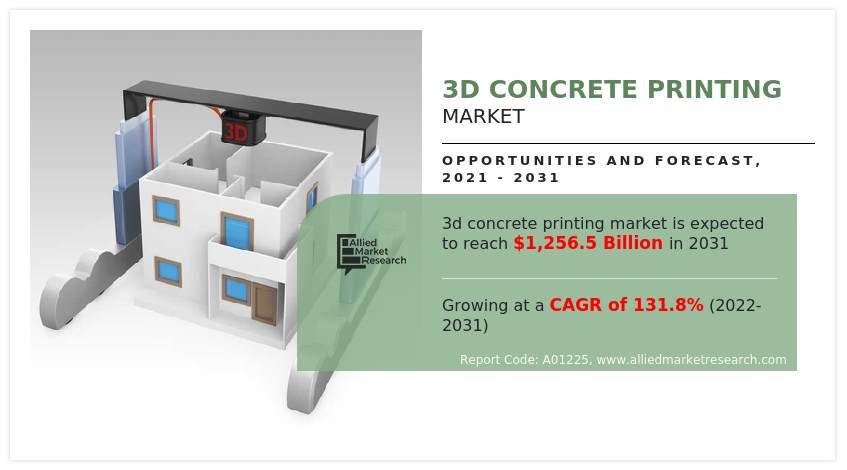
3D Concrete Printing Market Dynamics
The growth of the global 3D concrete printing market is driven by the high cost of skilled labor in developed countries. In addition, manual construction process generates construction waste, which subsequently needs to be collected and demolished. The wastage of concrete increases the project cost for the contractor and the collection & demolition cost for the government. On the contrary, 3D printing generates little waste as compared to the manual process. Moreover, the mass production of irregular shapes of objects is easier and more economical with the use of this technology.
However, high capital cost of 3D printer, its maintenance, and its operating software, as well as hardware acts as a major restraint to the market growth. The limitation on printing sizes and heights is another drawback, which hampers the growth of the market and technology globally. 3D concrete printing of huge objects needs a larger setup for the printer to travel the distance. Similarly, 3D printing needs cranes or other provisions to carry the printer to the desired height. This increases the capital and operation cost of the project, owing to the larger setup of frames, thereby restraining the 3D concrete printing market growth.
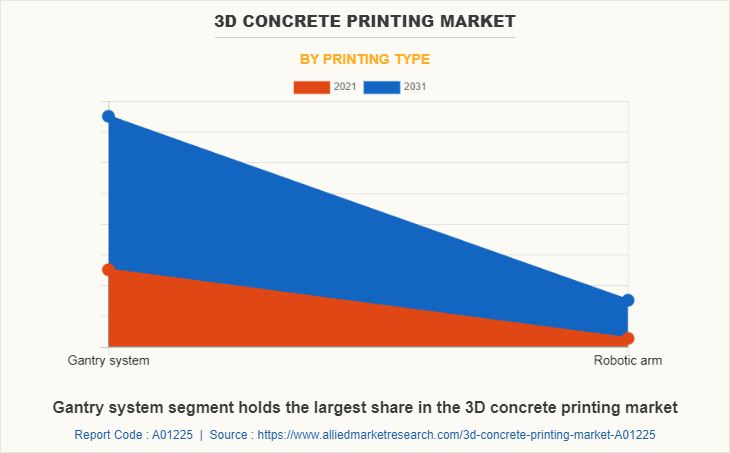
During the outbreak of the COVID-19 pandemic, the construction, manufacturing, hotel, and tourism industries were majorly affected. Manufacturing activities were halted or restricted. Construction and transportation activities, along with their supply chains, were hampered on a global level. This led to a decline in the demand for construction and 3D concrete printing, thereby restraining the growth of the 3D concrete printing market. Now, industries are gradually resuming their regular manufacturing and services. This is expected to lead to the re-initiation of 3D concrete printing companies at their full-scale capacities, which helped the 3D concrete printing industry to recover by the end of 2021.
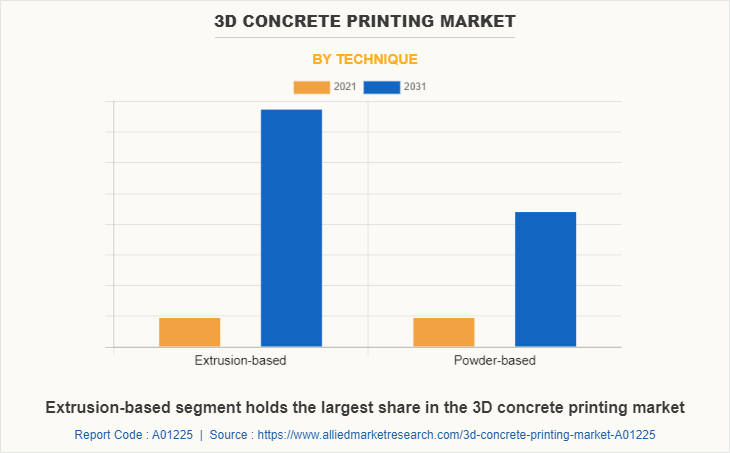
Rapid urbanization demands fast and accurate, yet cheaper and waste-free construction. These demands are met by 3D concrete printing technology. Thus, enovation and upgrade of walls, roofs, and separating panels in buildings and infrastructure are anticipated to offer remunerative opportunities for the expansion of the 3D concrete printing market during the forecast period.
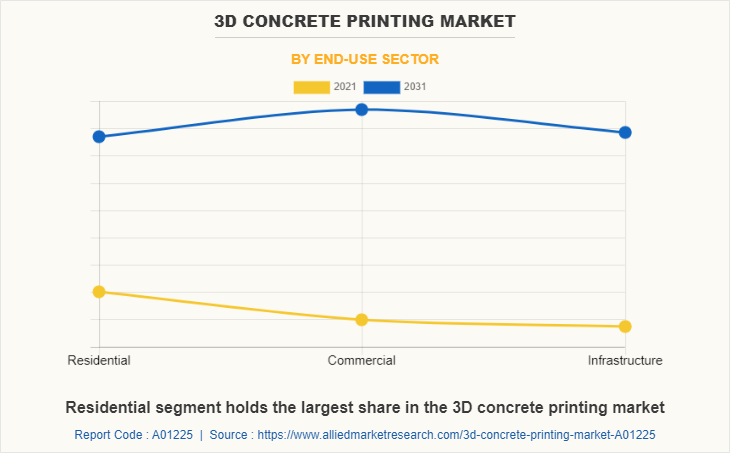
3D Concrete Printing Market Segment Overview
The 3D Concrete Printing Market analysis is segmented into Printing Type, Technique and End-use Sector. Region-wise, the market is analyzed across North America, Europe, Asia-Pacific, and LAMEA.
By Printing Type, In 2021, the gantry system segment dominated the market in terms of revenue, and the robotic arm segment is expected to witness growth at the highest CAGR during the forecast period.
On the Basis of Technique, the extrusion-based segment led the market in 2021 in terms of revenue, and the powder-based segment is anticipated to register the highest CAGR during the forecast period.
On the Basis of End-Use Sector, the residential segment led the 3D concrete printing market share in 2021 in terms of revenue, and the infrastructure segment is anticipated to register the highest CAGR during the forecast period.
Region-Wise, the Asia-Pacific region accounted for the highest market share in 2021, and LAMEA is anticipated to register the highest CAGR during the forecast period.
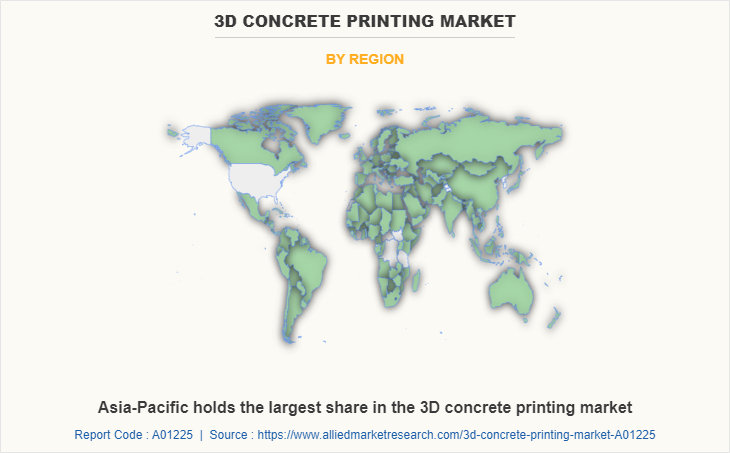
Major Players Profiled In the 3D Concrete Printing Market Include,
Apis Cor, Cobod International A/S, CyBe Construction, D-shape, Heidelbergcement AG (ItalcementiSpA), LafargeHolcim, Sika AG, Skanska, Yingchuang Building Technique (Shanghai) Co., Ltd. (Winsun), and XtreeE. Major companies in the market have adopted acquisition, partnership, and business expansionas their key developmental strategies to offer better products and services to customers in the market.
What are the Key Benefits for Stakeholders
- This report provides a quantitative analysis of the market segments, current trends, estimations, and dynamics of the 3D concrete printing market forecast from 2022 to 2031.
- The market research is offered along with information related to key drivers, restraints, and opportunities.
- Porter's five forces analysis highlights the potency of buyers and suppliers to enable stakeholders make profit-oriented business decisions and strengthen their supplier-buyer network.
- In-depth analysis of the 3D concrete printing market opportunities.
- Major countries in each region are mapped according to their revenue contribution to the global market.
- Market player positioning facilitates benchmarking and provides a clear understanding of the present position of the market players.
- The report includes the analysis of the regional as well as global 3D concrete printing market trends, key players, market segments, application areas, and market growth strategies.
3D Concrete Printing Market Report Highlights
| Aspects | Details |
| Market Size By 2031 | USD 1256.5 billion |
| Growth Rate | CAGR of 131.8% |
| Forecast period | 2021 - 2031 |
| Report Pages | 210 |
| By Printing Type |
|
| By Technique |
|
| By End-use Sector |
|
| By Region |
|
| Key Market Players | D-shape, Cobod International A/S, Apis Cor, Holcim, cybe construction, Sika AG, Yingchuang Building Technique (Shanghai) Co., Ltd. (Winsun), XtreeE, HeidelbergCement AG, Skanska AB |
Analyst Review
The utilization of 3D concrete printing service is expected to increase, owing to rapid urbanization and environmental awareness. Moreover, significant technological advancements in 3D printing technology fuel the market growth. In 2021, Asia-Pacific region was the highest revenue contributor to the global market, whereas LAMEA is expected to offer lucrative opportunities to the key players in the market.
Solution to overcome high labor cost, accuracy in complex design products, and cost-efficiency in mass production drive the 3D concrete printing market growth. However, high investment costs and limitation of printer considering the size of the objects to be printed impede the market growth. On the contrary, advanced technology used for building in developed nations is expected to create lucrative opportunities for the expansion of the 3D concrete printing market during the forecast period.
However, the technology has some challenges such as development of exact raw material, low material strength, poor surface finish, and lack of technical expertise on software and hardware. Research and development by the players in the market will make it possible to overcome these challenges and therefore boost the market growth during the forecast period. Thus, companies are adopting strategies like business expansion, product launch, and partnership to overcome these challenges and drive the growth of the market. For instance, in June 2020, LafargeHolcim introduced its first dry mortar range that is suitable for 3D printing.
The global 3D concrete printing market was valued at $371.7 million in 2021, and is projected to reach $1,256,522.8 million by 2031, registering a CAGR of 131.8% from 2022 to 2031.
The forecast period considered for the global 3D concrete printing market is 2022 to 2031, wherein, 2021 is the base year, 2022 is the estimated year, and 2031 is the forecast year.
To get latest version of global 3D concrete printing market report can be obtained on demand from the website.
The base year considered in the global 3D concrete printing market report is 2021.
The major players profiled in the 3D concrete printing market include Apis Cor, Cobod International A/S, CyBe Construction, D-shape, Heidelbergcement AG (ItalcementiSpA), LafargeHolcim, Sika AG, Skanska, Yingchuang Building Technique (Shanghai) Co., Ltd. (Winsun), and XtreeE.
The top ten market players are selected based on two key attributes - competitive strength and market positioning.
The report contains an exclusive company profile section, where leading companies in the market are profiled. These profiles typically cover company overview, geographical presence, market dominance (in terms of revenue and volume sales), various strategies and recent developments.
By printing type, the gantry segment is the highest share holder of 3D concrete printing market.
Loading Table Of Content...



